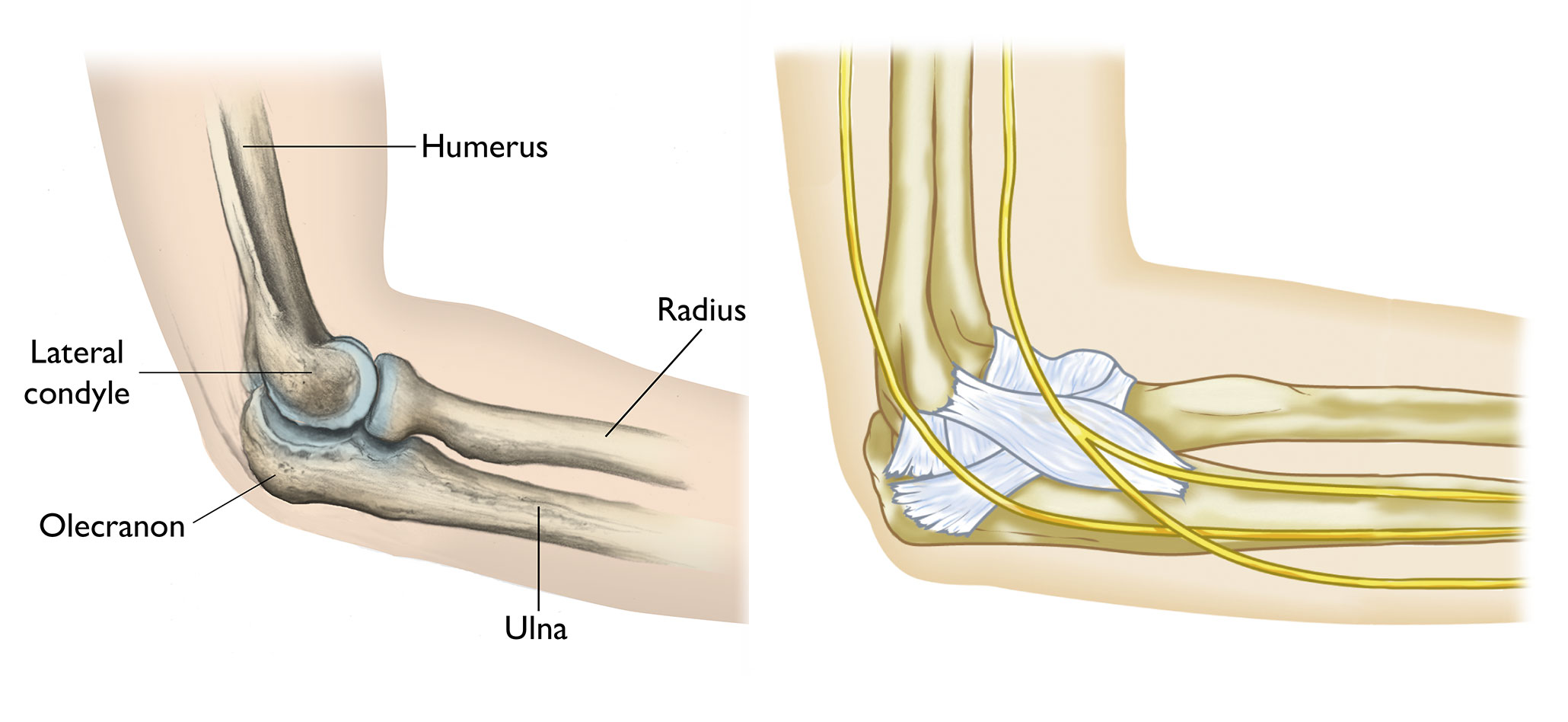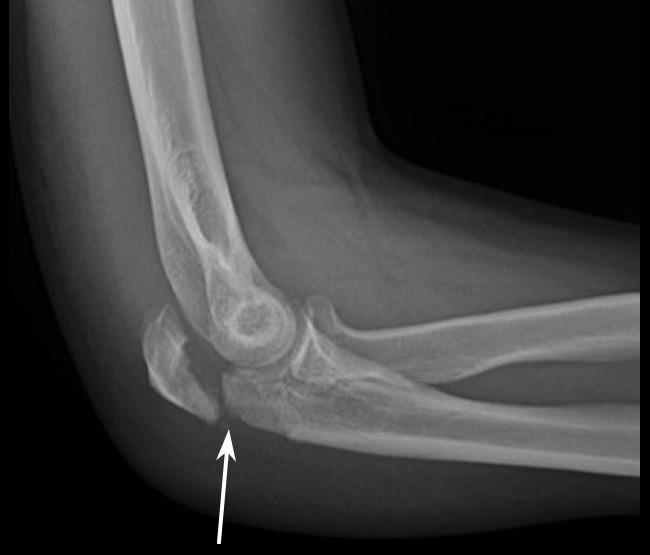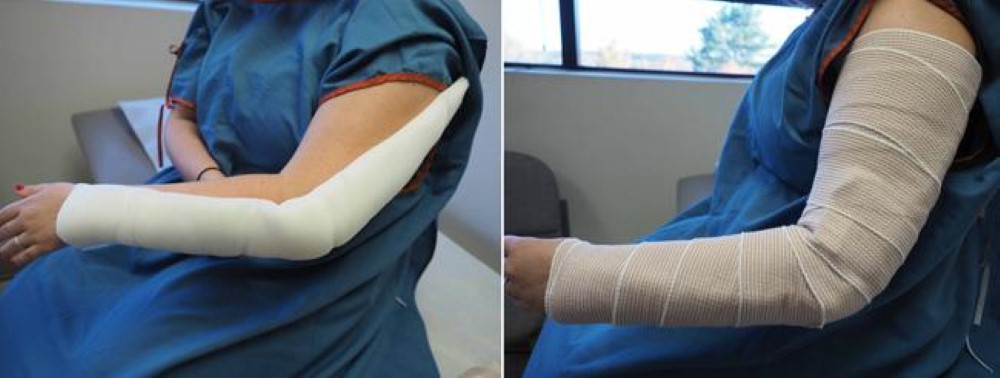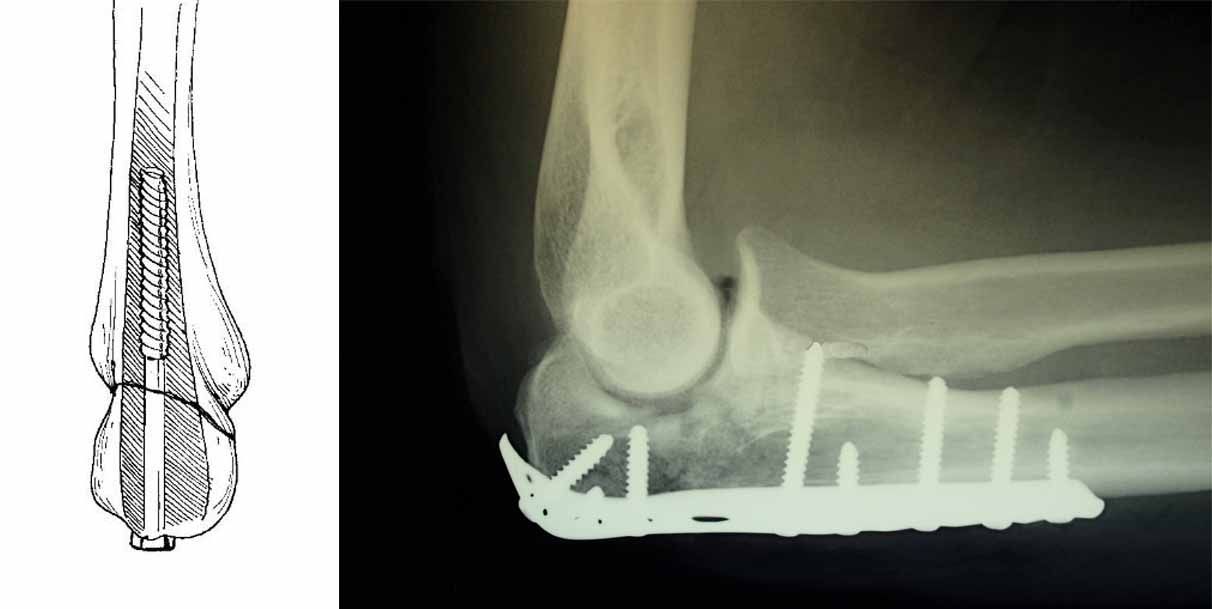Diseases & Conditions
Elbow (Olecranon) Fractures
An olecranon (oh-LEK-rah-nun) fracture is a break in the bony tip of the elbow. This pointy segment of bone is part of the ulna, one of the three bones that come together to form the elbow joint.
The olecranon is positioned directly under the skin of the elbow, without much protection from muscles or other soft tissues. It can break easily if you experience a direct blow to the elbow or fall onto the tip of the elbow. A fracture can be very painful and make elbow motion difficult or impossible.
Treatment for an olecranon fracture depends upon the severity of the injury.
- Some simple fractures can be treated by wearing a splint until the bone heals.
- In most olecranon fractures, however, the pieces of bone move out of place when the injury occurs. For many patients with these fractures, surgery is recommended to restore both the normal anatomy of the elbow and motion in the joint.
Anatomy
The elbow is a joint made up of three bones:
- The humerus (upper arm bone)
- The radius (forearm bone on the thumb side)
- The ulna (forearm bone on the pinky side)
The elbow joint bends and straightens like a hinge. It is also important for rotation of the forearm: that is, the ability to turn your palm up (like accepting change from a cashier) or palm down (like typing or playing the piano).
The elbow consists of portions of all three bones:
- The distal humerus is the lower end of the humerus. It forms the upper part of the elbow and is the spool around which the forearm bends and straightens.
- The radial head is the knobby end of the radius where it meets the elbow. It glides up and down the front of the distal humerus when you bend your arm and rotates around the ulna when you turn your wrist up or down.
- The olecranon is the part of the ulna that cups the lower end of the humerus, creating a hinge for elbow movement. The bony point of the olecranon can easily be felt beneath the skin because it is covered by just a thin layer of tissue.
The elbow is held together by its bony architecture, as well as ligaments, tendons, and muscles. Three major nerves cross the elbow joint.
Description
Olecranon fractures are fairly common. Although they usually occur on their own with no other injuries, they can also be part of a more complex elbow injury.
In an olecranon fracture, the bone can crack just slightly or break into many pieces. The broken pieces of bone may line up straight or may be far out of place (displaced fracture).
In some cases, the bone breaks in such a way that bone fragments stick out through the skin or a wound penetrates down to the bone. This is called an open fracture. Open fractures are particularly serious because once the skin is broken, infection in both the wound and the bone are more likely to occur. Immediate treatment is required to prevent infection.
Cause
Olecranon fractures are most often caused by:
- Falling directly on the elbow
- Receiving a direct blow to the elbow from something hard, like a baseball bat, or a dashboard or car door during a vehicle collision.
- Falling on an outstretched arm with the elbow held tightly to brace against the fall. In this situation, the triceps muscle, which attaches to the olecranon, can pull a piece of the bone off of the ulna. Injuries to the ligaments around the elbow may occur with this type of injury, as well.
Symptoms
An olecranon fracture usually causes sudden, intense pain and can prevent you from moving your elbow. Other signs and symptoms of a fracture may include:
- Swelling over the tip or back of the elbow.
- Bruising around the elbow. Sometimes, this bruising travels up the arm toward the shoulder or down the forearm toward the wrist.
- Tenderness to the touch.
- Numbness in one or more fingers.
- Pain with movement of the elbow or with rotation of the forearm.
- A feeling of instability in the joint, as if your elbow is going to pop out.
Doctor Examination
Physical Examination
Your doctor will talk with you about your medical history and general health and ask about your symptoms. They will then examine your elbow to determine the extent of the injury. During the exam, your doctor may:
- Check your skin for cuts, swelling, blistering, and bruising. In severe fractures, bone fragments can break through the skin, increasing the risk of infection.
- Palpate (feel) all around your elbow to determine if there are any other areas of tenderness. This could indicate other broken bones or injuries, such as a dislocated elbow.
- Check your pulse at the wrist to ensure that there is good blood flow to your hand and fingers.
- Check to see that you can move your fingers and wrist and can feel things with your fingers.
Although you may have pain only at the elbow, your doctor may also examine your shoulder, upper arm, forearm, wrist, and hand to ensure that you do not have any other injuries.
X-rays
X-rays provide images of dense structures, such as bones. Your doctor will order X-rays of your elbow to help diagnose your fracture. Depending on your symptoms, the doctor may also order X-rays of your upper arm, forearm, shoulder, wrist, and/or hand to determine whether you have other injuries.
Treatment
While you are in the emergency room, your doctor will usually apply a splint (like a cast) to your elbow and give you a sling to help keep the elbow in position. Immediate treatment may also include:
- Applying ice to reduce pain and swelling
- Medications to relieve pain
Your doctor will determine whether your fracture requires surgery. Many olecranon fractures will require surgery.
Nonsurgical Treatment
If the pieces of bone are not out of place, a fracture can sometimes be treated with a splint to hold the elbow in place during healing. During the healing process, your doctor will take frequent X-rays to make sure the bone has not shifted out of place.
You will typically wear a splint for 2 weeks before switching to a brace and starting gentle motion. If the fracture shifts in position during this time, you may need surgery to put the bones back together.
In older patients or those with lower demands, even if the fracture is displaced, nonoperative management may be an option. Your doctor will discuss your condition and treatment recommendations with you.
Surgical Treatment
Surgery is usually recommended for olecranon fractures in which:
- Pieces of bone have punctured the skin (open fracture
- The bones have moved out of place (displaced fracture) in young, healthy patients
- The joint is unstable (out of alignment)
Surgery for olecranon fractures typically involves putting the broken pieces of bone back into position and fixating them to keep them from moving out of place until they are healed.
Because of the increased risk of infection, most open fractures are scheduled for surgery as soon as possible, usually within 24 hours of the diagnosis. Patients are given antibiotics by vein (intravenous) in the emergency room and may receive a tetanus shot. During surgery, the cuts from the injury and the surfaces of the broken bone are thoroughly cleaned out. The bone will typically be repaired during the same surgery.
Surgical Procedures
Open reduction and internal fixation. This is the procedure most often used to treat olecranon fractures. During the procedure, the bone fragments are first repositioned (reduced) into their normal alignment. The pieces of bone are then held in place with screws, wires, pins, sutures, or metal plates attached to the outside of the bone.
Some common methods of internal fixation are shown below.
Bone graft. If some of the bone has been lost through the wound or is crushed, the fracture may require bone graft to fill the gaps. Bone graft can be taken from a donor (allograft) or from another bone in your own body (autograft). In some cases, an artificial material can be used instead of bone graft.
Complications of Surgery
There are risks associated with any surgery. If your doctor recommends surgery, they think that the possible benefits outweigh the risks.
Potential complications include:
Elbow stiffness. One of the most common problems patients face after any fracture around the elbow is stiffness. It is very important to begin physical therapy as directed to avoid elbow stiffness. Typically, patients with fractures that are fixed begin with early range of motion to help prevent stiffness. In most cases, the injured elbow will be permanently a bit stiffer than it was before the injury, even with physical therapy.
Infection. There is a risk of infection with any surgery. Your doctor will take specific measures to help prevent infection, including giving you antibiotics before surgery. Antibiotics are not usually needed after surgery.
Hardware irritation. A percentage of patients may experience irritation from the metal implants used to repair the fracture.
Damage to nerves and blood vessels. There is a risk of damage to normal structures, such as nerves and blood vessels, around the elbow.
Nonunion. Sometimes, a fracture does not heal. The fracture may pull apart and the screws, plates, or wires may shift or break. This can occur for a number of reasons, including:
- The patient does not follow directions after surgery.
- The patient has a health problem, such as diabetes, that slows healing. Smoking or using other tobacco products also slows healing. Learn more: Smoking and Surgery
- If the fracture was associated with a cut in the skin (open fracture), healing is often slower.
- Infections can also slow or prevent healing.
If the fracture fails to heal, you may need further surgery.
Recovery
Pain Management
Most fractures hurt moderately for a few days to a couple of weeks. Many patients find that using ice, elevation (holding their arm up above their heart), and non-prescription pain medications are sufficient to relieve pain.
If your pain is severe, your doctor may suggest a prescription-strength medication, such as an opioid, for a few days.
Be aware that although opioids help relieve pain after surgery, their use has risks and complications. These medications can be addictive and potentially dangerous. It is therefore important to use opioids only as directed by your doctor, to use as little as possible for as short a time as possible, and to stop taking them as soon as your pain starts to improve.
Rehabilitation
Whether your treatment is surgical or nonsurgical, full recovery from an olecranon fracture requires a good effort at rehabilitation.
Recovery After Nonsurgical Treatment
Because nonsurgical treatment can sometimes require long periods of splinting or casting, your elbow may become very stiff. For this reason, you may need physical therapy to regain motion, although it is important to understand that many patients will experience some permanent loss of motion.
During rehabilitation, your doctor or a physical therapist will provide you with exercises to help:
- Improve range of motion
- Decrease stiffness
- Strengthen the muscles within the elbow
You will not be allowed to lift, push, or pull anything with your injured arm for a few weeks. Your doctor will talk with you about specific restrictions.
Recovery After Surgical Treatment
Depending on the complexity of the fracture and the stability of the repair, your elbow may be splinted or casted for a short period of time after surgery.
Physical or occupational therapy (PT or OT). Patients will usually begin exercises to improve motion in the elbow and forearm shortly after surgery, sometimes as early as the next day. It is extremely important to perform the exercises as directed. The exercises will only make a difference if they are done regularly.
Restrictions. You will not be allowed to lift heavy objects with your injured arm for a period of time after surgery. You will also be restricted from pushing and pulling activities, such as opening doors or pushing up while rising from a chair. You may be allowed to use your arm for bathing, dressing, and feeding activities. Your doctor will give you specific instructions. They will also let you know when it is safe to drive a car.
Complications of Olecranon Fractures
Even with successful treatment, some patients with olecranon fractures may experience long-term complications.
Loss of Motion
In most cases, a patient may not be able to regain full motion in the affected elbow. In most of these cases, the patient cannot fully extend or straighten their arm. Fortunately, the loss of a few degrees of straightening does not usually affect the overall function of the arm. Patients who have substantial loss of motion may require intensive therapy, special bracing, or further surgery. This is uncommon for olecranon fractures.
Posttraumatic Arthritis
Posttraumatic arthritis is a type of arthritis that develops in a joint after an injury. Even when your bones heal normally, the cartilage lining the joint surfaces is often damaged, leading to pain and stiffness over time.
Posttraumatic arthritis is a relatively common complication of olecranon fractures. It can occur shortly after the fracture occurs or can take years to develop. Some patients with posttraumatic arthritis may need further surgery to relieve their symptoms. However, for many patients, there is little pain and no need for further treatment.
Outcomes
Most patients can return to their normal activities within about 4 months, although full healing can take more than a year. Recovering strength in your arm often takes longer than might be expected.
Although X-rays may show that the fracture has healed completely, some patients report that they still have limitations in movement. These patients will usually continue to improve over time.
Contributed and/or Updated by
Peer-Reviewed by
AAOS does not endorse any treatments, procedures, products, or physicians referenced herein. This information is provided as an educational service and is not intended to serve as medical advice. Anyone seeking specific orthopaedic advice or assistance should consult his or her orthopaedic surgeon, or locate one in your area through the AAOS Find an Orthopaedist program on this website.














